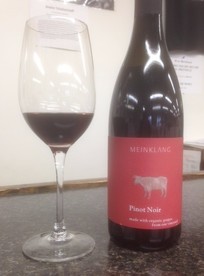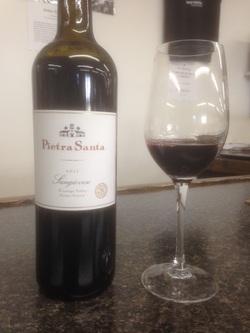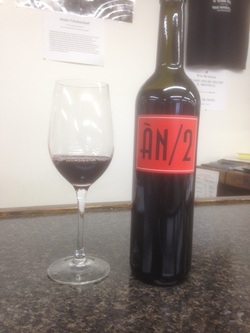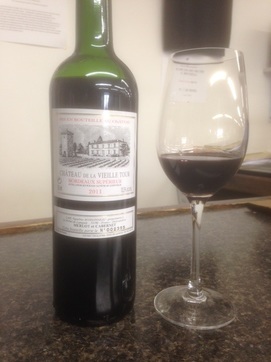 This is routinely one of our favorite 'forgotten' wines in the store, where we get in the routine of showing customers Pinot Noirs from the usual suspect areas like California, Oregon, or Burgundy. You would think that if it came from a region called Burgenland it would stick in our collective brains a little better. But that is what the Insider's Pick is best used for, to bring these gems to light. Austria in general has produced some exciting interpretations of Pinot Noir over recent years, but this house in particular has really nailed it for both quality and value vintage after vintage. Certified Biodynamic, this has always been a house that brings the farm mentality to fine wine for a remarkable price. Despite being in a warmer climate, the Burgenland Pinot Noirs always seem to follow more of a French style (power of suggestion, perhaps?), and the Meinklang drinks like a quality 'basic' Burgundy. Savory cherry skins and hints of earthy red fruits start on the aroma, with perhaps a bit of New World style sweeter red fruit coming through as it opens up, but overall staying very savory. The palate isn't as acidic as most Burgundies, and some would say that's to it's benefit as it takes some of the harsher edges off the higher toned red fruit character. There is a softer mouthfeel behind the cranberry and Bing cherry, allowing some of the more subtler herb and savory earth flavors through. A great deal for Pinot Noir no matter where it came from!
0 Comments
 While Italy is considered one of the great wine growing countries in the world, their grape varieties haven't traveled the globe nearly as well as the wines themselves. You don't see dozens of labels on every store shelf for Vernaccia or Nebbiolo from multiple countries the way you do Chardonnay or Cabernet Sauvignon. Primitivo could make some claim, but it is better known by its American name of Zinfandel, its genealogy is muddled, and has struggled for recognition even in its home region of Apulia. When their production shows up it is usually as a labor of love versus satisfying a popular need, and this winery from California's underrated Cienga Valley looks to celebrate their Italian heritage while not trying to directly replicate Tuscan wines. Deep ruby in the glass, the aromas are juicier and spicier than a Chianti, but there is a hint of dusty earthiness in the background that does recall a bit of the Old Country.On the palate the texture is definitely New World, lush and polished, full of forward spiced cherry and raspberry fruits. Still in the background there is a lingering dark spice bitterness that keeps the wine well away from being 'fruity', a style that kills off Sagiovese's subtle charms. While this won't get confused with anything carrying a DOC or DOCG designation, it does the variety justice and doesn't fall into the cookie-cutter form of the 'typical' Californian wine.  Mallorca is the main island of the Balearics, a cluster off the coast of Valencia with strong Catalonian influence. It is best known as a tourist getaway featuring quaint old towns, plenty of beaches, and one of the great under-the-radar seafood destination in the Mediterranean. Wine has existed here since the 1700s; in fact a sizable portion of early Californian wine history stems from the Franciscan monks in Mallorca bringing vines with them during their earliest pilgrimages. But it never really kept pace with the more famous regions on the mainland. The prosperity and growth that Spain's vineyards saw during the late 1900s and early 2000s extended to Mallorca (as well as the Canary Islands), bringing investments in modern techniques and equipment, and sorting out the best of the local varieties to bring the local character to the international stage. Anima Negra was founded at the early stages of this quality explosion, started modestly by a group of friends re-purposing milk tanks into fermenters, but now are at the forefront of Mallorcan wines. This wine features a mix of the traditional and the modern. blending the two most noted local varieties Callet and Mantonegre-Fogoneu with the more familiar Syrah. A deep ruby color but not thick and opaque-looking, the native varieties are all over the aroma with wild raspberry and black fruits as well as warm sunny spices. The palate is fairly juicy with lots of savory tones in with the fruit and a very polished silky texture similar to a youthful but serious Pinot Noir. This is definitely not one of the more heavily oaked and fruit forward wines that has become more common in Spain in recent years, as the Mallorcan grapes have a unique character that plays out all the way through the earthy, somewhat gamey finish. A great food wine that works with spiced and flavorful red meat dishes. |
The Best of the Best.We offering free tastings on these wines in the store every Thursday and Friday, and a 10% discount off the retail price through the duration of the day. Come on by and give them a try! Archives
July 2024
Categories |
Location |
|


 RSS Feed
RSS Feed